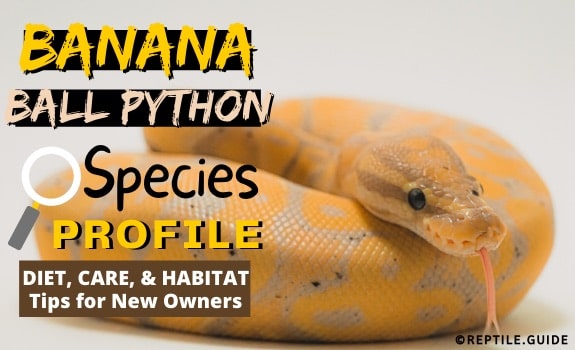Banana Ball Pythons are a form of color morph (opens in new tab) of the standard ball python.
They’re named “banana” after their bright yellow coloration and dark brown or black speckling, curiously similar to an aging banana!
The ball python species’ nomenclature is derived from their tendency to coil into a tight ball in the face of danger. Typical, wild-type ball pythons are light brown and black.
This morph was discovered in the late 1990s or early 2000s. The original animals were wild-caught imports. Early on, captive-produced banana ball pythons sold for well over $10,000 each!
Banana ball pythons have both the striking visual appeal and well-understood care requirements to make them an excellent pet for hobbyists (for a number of reasons!) that are new to keeping tropical species.
Let’s learn more!
In This Article
What is a Banana Ball Python?
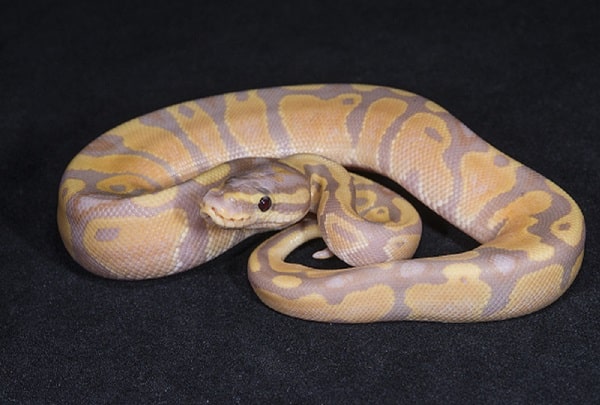
Banana Ball Pythons are a morph of the Ball Python, Python regius.
Ball Pythons are a part of the Pythonidae family of snakes, which includes some of the largest snakes in the world. Pythons are non-venomous constrictors that are generally heavy-bodied. Around 40 species of python are currently recognized.
Ball Pythons are part of the Python genus, which are considered the true pythons. Other members of this genus include the infamous Burmese python, short-tailed pythons, and rock pythons.
Even wild Ball Pythons are rodent eaters. They’re ambush predators that find and hide in burrows, waiting for their prey to arrive.
After they finish digesting, they move on to another den. A typical natural prey species is the African Soft-Furred Rat, which is also readily available in captivity. In nature, they’ll also eat young nestling birds, gerbils, shrews, and mice.
Ball Pythons are native to West and Central Africa. They live in humid grasslands and similar biomes.
When stressed or frightened, Ball Pythons will curl into a tight ball, keeping their head safe and protected in the center of the coil. That’s how they got their common name!
Like many other python species, Ball Pythons have maternal behavior patterns. They will defend the nest and incubate the eggs, using a twitchy, shivering motion to increase the eggs’ temperature.
The Banana morph was originally called Coral Glow and/or White Smoke.
The founders of the Banana Ball Python, Will Slough and Kevin McCurley, began working on it in the early 2000s.
The Banana mutation replaces a normal Ball Python’s black coloration with a striking silver-purple hue. The light brown of a wild-type Ball Python is, instead, bright “banana” yellow in a Banana Ball Python. As a Banana Ball Python matures, it develops black or brown speckling, just like the fruit.
The Banana gene is the first gender-linked mutation discovered in Ball Pythons.
The Banana morph is dominant, meaning only one parent needs to carry the gene for some of the offspring to be Banana, too.
As a result, the Banana Ball Python is sometimes bred with the Enchi Ball Morph to create Banana Enchi Ball Pythons.
This produces snakes with the Banana’s striking yellow or orange colors but with the enchi markings.
Similarly, Banana Fire Ball Pythons are the offspring of a Banana morph and a Fire Ball Python Morph.
As a morph, the Banana is truly versatile. Another beautiful combination is the Banana x Orange Dream Morph, which—due to co-dominance—will always yield a banana orange dream.
Do Banana Ball Pythons Make Good Pets?
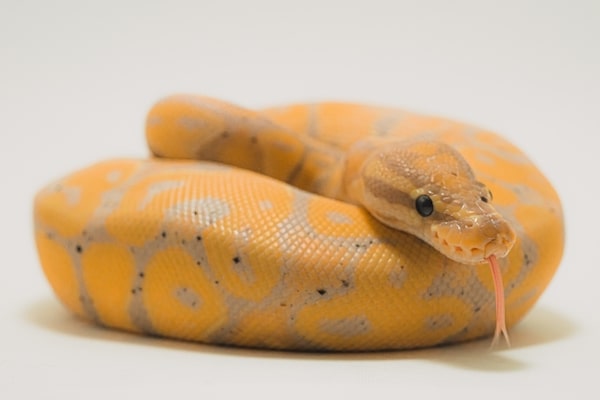
Yes, Banana Ball Pythons are one of the BEST choices for new snake owners that are interested in keeping tropical reptiles and willing to do the required research.
The fact of the matter is that they are not as easy to care for, and may be considered a step up in difficulty, from standard North American colubrids like king snakes and corn snakes.
In addition to their higher heat and humidity requirements, Banana Ball Pythons tend to be more finicky eaters, which may cause some inexperienced reptile keepers to panic when hunger strikes occur.
However, do not worry too much about this as this species can safely go months without a meal.
Once they’re comfortable with their new surroundings and the sight and scent of their handler (you!), they tolerate and sometimes even seem to enjoy being handled and having the ability to explore outside of their day-to-day habitat.
Even scared, shy Banana Ball Pythons rarely bite. Instead, they usually coil into a tight ball.
Banana Ball Pythons are an excellent choice for kids.
Their beefy, compact bodies make them perfectly easy to handle. They’re too large to accidentally injure with tight-gripping hands and too small to cause any serious injury to humans.
This species is also relatively inactive and slow-moving, which may be comforting for new handlers.
Finally, the striking coloration of Banana Ball Pythons is excellent for drawing admiration from everyone, including family members and friends who may be nervous or afraid of Ball Pythons.
After all, how can you be scared of something that is purple, with a name like “Banana”?!
Behavior & Temperament
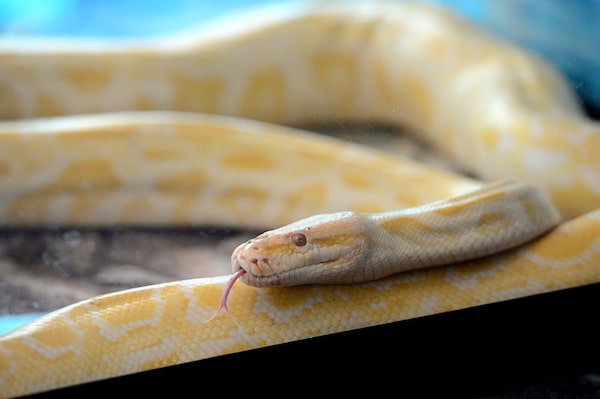
Ball Pythons are a shy, mostly inactive species of snake.
A healthy, happy, comfortable Ball Python will find the ideal spot hiding spot in their terrarium and stay in that spot for up to several days.
They also enjoy exploring, especially when they are hungry.
When you are handling your Banana Ball Python, or it is exploring its habitat, it should move slowly and calmly, without any shakiness, wobbliness, or lack of balance.
It may also be content to sit still in your arms and chill with you for a while.
🤓 Expert Tip: Extreme, constant movement and activity in your Banana Ball Python may indicate a problem with the temperature, humidity, lighting, health, or secure hiding locations.
Tongue-flicking is also a sign of a healthy, curious, and comfortable snake trying to learn more about its environment.
If your Banana Ball Python feels stressed or threatened, it will coil into a tight ball, with its head and neck tucked safely into the center of the ball. If any harassment continues, the snake will begin hissing.
Ball Pythons rarely bite defensively or as a result of stress. Defensive bites are typically fast, and the snake lets go right away. It may strike more than once.
Bites caused by your snake’s feeding response are more common, especially for novice handlers.
When a Ball Python bites as part of a feeding response, it usually does not let go and wraps around your arm or hand. Never try to pull it off because teeth could tear off and stay embedded in your skin. This can cause an infection in you and your pet. Running cold water over your Ball Python’s head should convince it to release itself.
You can avoid feeding response bites by tapping your Ball Python with a snake hook or stick every time you reach into its enclosure or handle it, to let it know that it’s NOT feeding time.
Be sure to wash your hands thoroughly every time you will be handling your Ball Python.
This helps prevent the spread of disease, parasites, and removes the odor of anything that might smell like food to your pet.
Ball Python bites AREN’T serious or life-threatening and rarely require emergency medical attention.
The pain is usually less severe than a cat scratch. Washing the wound, and applying a topical antibiotic, and covering it with a bandage should be sufficient.
Banana Ball Python Care Sheet
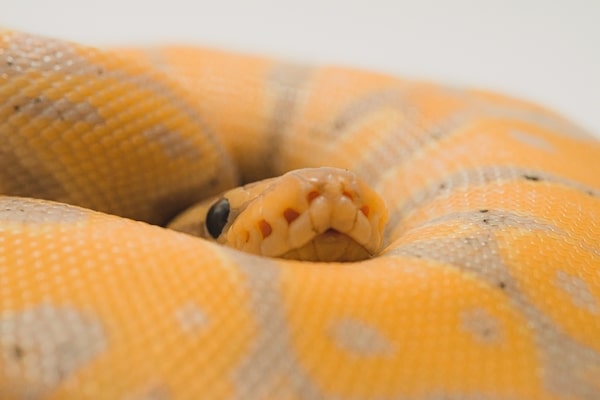
Caring for any exotic wild animal, especially ectothermic reptiles, requires careful thought and consideration – and lots of research.
Luckily, we’ve compiled all of the essential care information you’ll need into this handy care sheet.
Your primary goals when preparing your Banana Ball Python’s habitat are:
- Heat
- Humidity
- Security
Being a shy species, they’ll need lots of opportunities to hide and cover themselves, at least partially.
Keep in mind that snakes are restricted to their enclosure day-in and day-out.
Offer TONS of enrichment and exercise opportunities, and try to mimic their natural habitat as much as you safely and affordably can.
Tank Size
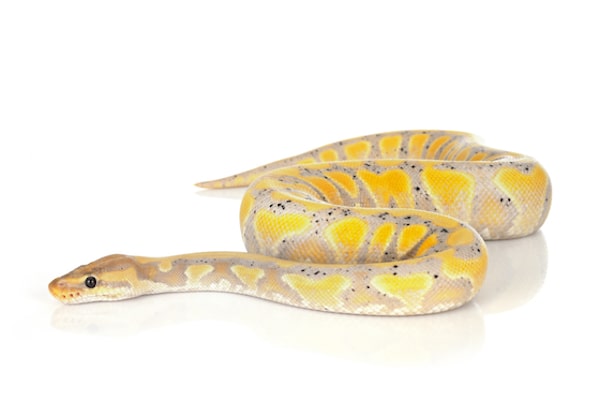
Hatchling and Juveniles under 20 inches: 15-20 gallon tank
Juveniles and Adults under 3 feet long: 40 gallon tanks
3 Foot+ Long Adult Enclosure Minimum Dimensions: 120 gallons (48”L x 24”W x 12”H)
PVC enclosures are the golden standard for Banana Ball Pythons, thanks to their ability to maintain the high temperature and humidity level required by this species.
Most homemade and manufactured PVC enclosures have clear sliding glass doors in the front, and solid sides, which will help your Banana Ball Python feel secure.
If you’re handy, you can build a similar wooden enclosure. Be sure to thoroughly seal the inside surfaces, due to the exposure to high humidity, urine, and spilled water bowls.
Plastic tubs are a great, economical choice, too. You won’t be able to see your little friend unless you remove the lid, but they will feel safe, secure, warm, and humid!
Glass and acrylic aquariums and terrariums are not quite as ideal, but they can work in a pinch. The wire lid should be covered to prevent evaporation and heat loss from inside the habitat.
Humidity
As we mentioned previously, Banana Ball Pythons need additional humidity.
While average household humidity is generally 40-50%, the humidity in your Banana Ball Python’s habitat should NEVER drop below 50%.
The ideal humidity is 55-60%, and even slightly higher for hatchlings.
If your Banana Ball Python doesn’t shed one complete, whole piece of skin, this is a sign that you need to bump up the humidity level.
Lighting and Temperature
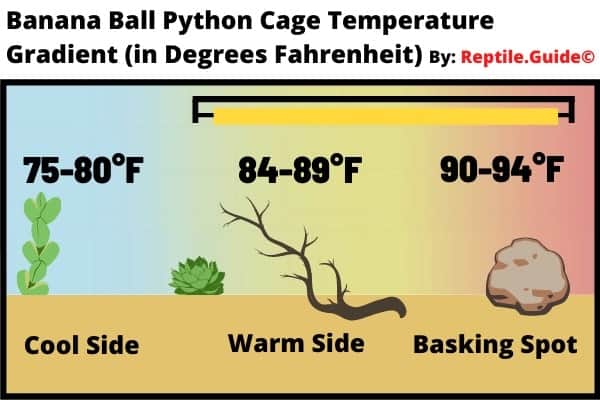
The correct temperature gradient is imperative for all snakes, including Banana Ball Pythons.
These animals need access to a range of temperatures to thermoregulate for optimum health and digestion. Be sure that your snake has access to warm areas and cool areas.
Warm Side: 84-89°F
Basking Surface: 90-94°F
Cool Side: 75-80°F
Night-time Temperature Drop (optional): 72-78°F
It is especially important to raise the ambient air temperature for ball pythons. Continuous room-temperature ambient air may eventually make them sick.
Heating pads and heat tape only increase the surface temperature. They’re useful in racks, which are small and insulated enough to allow surface temperature to raise the ambient temperature, or as a supplemental or night-time heat source.
Ceramic heat emitters, radiant heating panels, and heat bulbs are GREAT for raising any habitat’s ambient temperature.
Bulbs that emit light must only be used during the daytime, never more than 12 hours in 24 hours. Blue and red “night” bulbs are NOT recommended.
Lighting is not necessary for snakes, especially crepuscular burrow-dwelling species like the Banana Ball Python. Keeping the ambient room light on a 12 hours on, 12 hours off schedule mimics the day/night cycle your snake would experience in nature, which may serve as a source of enrichment.
Studies suggest that most snake species utilize natural sunlight and bask to some degree.
Since Banana Ball Pythons are unnaturally light-colored, they may be more sensitive to UVB rays, including the harmful side effects.
If you choose to give your Banana Ball Python a UV basking light, be sure to thoroughly research the correct strength, duration, and distance.
Substrate
One little-known fact about Ball Pythons is that they enjoy burrowing.
Most Ball Python owners don’t know this because they don’t keep their pets on a substrate that allows them to exhibit this natural behavior.
If you’d like to utilize this instinct as a source of natural enrichment (which you should!), be sure to choose a substrate that promotes burrowing.
Best Substrate Options:
- Soil can be purchased as a pre-made mix explicitly intended for reptiles, or you can mix your own with organic topsoil, washed play sand, and peat or sphagnum moss. This substrate looks completely natural and offers a high-contrast dark background, on which you can admire your bright and light-colored Banana Ball Python.
- Coconut coir or husks are cheap, safe, and naturally antibacterial and anti-fungal. They help to maintain a high humidity level. Coconut husks will not allow your Banana Ball Python to burrow, but coconut coir or coconut fiber will.
- Cypress mulch is an attractive choice that also holds up well with humidity, but it can be expensive and doesn’t allow your Ball Python to burrow. Some owners have reported that it can cause impaction or perforation if it’s accidentally ingested with a rodent, so use caution.
- Paper towels, newspaper, or butcher block paper are the cheapest options, but they aren’t the best for looking at or enriching your pet’s environment. These options are perfect for quarantine periods or when treating a sick snake because they allow you to inspect and collect feces easily
Worst Substrate Options:
- Pine or cedar shavings are toxic to snakes.
- Paper bedding is dusty and dry.
- Gravel presents impaction risks and zero odor absorption.
- Reptile carpet breaks down quickly after a few washings, is difficult to disinfect, and doesn’t let your Banana Ball Python burrow.
Decorations & Accessories
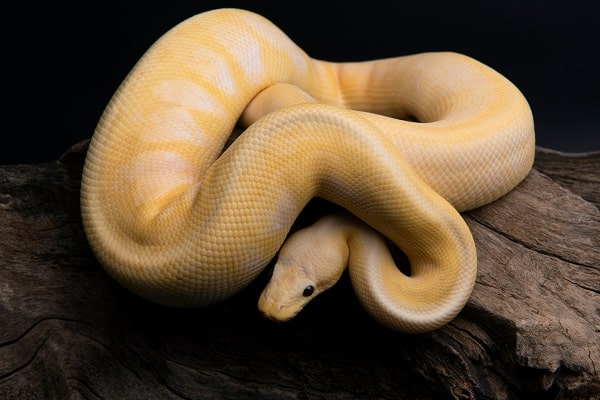
Banana Ball Pythons, like most snakes, feel the most secure in a cluttered environment where they can always hide at least portions of their body.
A water bowl that your Banana Ball Python can soak in is a must. Keep it on the warm side of the enclosure to maintain humidity levels.
Offer at least two hides, preferably three, with one on the warm side, one on the cool side, and the third optional hide filled with extra-moistened substrate, moss, or paper towels.
If you have space available for more hides, use it! Variety is the spice of life, and your Banana Ball Python will appreciate being able to choose between different textures, sizes, temperatures, and humidity levels.
Rocks, logs, and branches are excellent sources of enrichment and exercise for your Ball Python. Even though this species is considered terrestrial, they will happily climb to explore if given the opportunity.
Fill most of the extra empty space with plants, fake or live.
Diet & Feeding
Ball Pythons are bird and rodent eaters. In the wild, their diet consists of:
- African giant rats
- Black rats
- Rufous-nosed rats
- Shaggy rats
- Grass mice
- Natal multimammate mice, or African soft-furred rats
- Shrews
- Gerbils
- Striped mice
- Birds
Wild hatchling Ball Pythons feed almost exclusively on small, hatchling birds, while adult Ball Pythons feed mostly on mammals.
In captivity, the most common prey item available is the fancy rat, Rattus norvegicus domestica, a subspecies of the brown rat.
These still smell pretty different from their natural prey, so newly-captive and hatchling Ball Pythons may have difficulty adjusting to a diet of fancy rats.
It’s recommended to start all hatchling Ball Pythons out eating young rats instead of adult mice since it can be challenging to switch this species from mice to rats.
Once your Banana Ball Python becomes an established and regular eater, you might consider offering it different species of feeders, including chicks and gerbils.
This might help to bridge any nutritional gaps in a single-source diet.
However, many Ball Python owners find that offering variety can be risky since Ball Pythons tend to pick one favorite food source and refuse anything else.
🤓 Expert Tip: If your Banana Ball Python is reluctant to eat fancy rats, you might try offering one natural food source that can be obtained even in captivity: African soft-furred rats. Only switch to this prey source if you have a steady, reliable supplier, in case your snake refuses to eat anything else.
Wild Ball Pythons are infrequent feeders. Healthy, captive Ball Pythons can go as many as six months without eating and still not lose any considerable amount of weight.
Feeding frequency:
0-12 months: Every 5-7 days
Adults: Every 10-14 days
Health
Healthy Captive Ball Python Lifespan: 30+ Years (The record for a ball python is 47 years)
As with most snake species, issues usually stem from improper husbandry or outside sources. These issues can be hard to identify for many new snake keepers, so read carefully.
- Snake mites: Snake mites will cause your Banana Ball Python to shed frequently and soak in their water bowl for extended periods. You can purchase over-the-counter products or see your reptile veterinarian to eradicate mites.
- Mouth rot, scale rot, and respiratory infection: These infections are potentially life-threatening and need to be diagnosed and treated by a veterinarian. Keep an eye out for:
- Mouth gaping
- Raspy breathing
- Mucous from the mouth or nostrils
- Brown or discolored scales, especially on the belly
- Misshapen lips
- Internal Parasites: It’s wise to have your snake’s feces periodically checked for parasites by a veterinarian. They can usually be eradicated with a few simple treatments.
Signs that your Banana Ball Python is healthy and happy:
- Overall inactive, but alert and inquisitive when disturbed
- Shedding in one piece
- Not losing weight
- Good balance and strength with no shakiness or wobble
- Uses both the cool side and warm side of the enclosure
- Silent breathing
- Light-colored belly scales with no worsening brown or black discoloration
Handling and Bonding
While this species is generally pretty shy and solitary, most Banana Ball Pythons don’t mind being handled occasionally and within reason.
If your Banana Ball Python balls up as soon as you remove it from the enclosure, give it 5-10 minutes of calm and quiet surroundings to see if it un-balls to explore. If it stays balled up, put it back in the enclosure and try again tomorrow.
If your Banana Ball Python suddenly stops eating, this may be a sign that it is stressed from over-handling.
Try to avoid handling your Ball Python until it starts regularly eating again.
Avoid handling your Banana Ball Python for 48 hours after it has eaten and when its eyes are cloudy from going into shed.
When handling your Ball Python, do NOT grip it. Think of yourself as a tree, and your arms are branches that your Banana Ball Python is climbing and exploring.
Baby Banana Ball Pythons
Baby Banana Ball Pythons hatch from eggs that have incubated for 53-55 days. The typical Ball Python clutch is 3-11 eggs.
When they hatch, Banana Ball Pythons are usually around 10″ long and weigh approximately 50-100 grams.
Since the Banana mutation is considered a dominant gene, only one parent needs to be a Banana Ball Python for some of the babies to be Banana Ball Pythons, too.
You can start feeding Hatchling Ball Pythons pinkie rats after their first shed.
